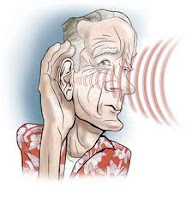From KXAN.com:
Many people suffer from hearing loss. In fact, the latest available statistics show that over 10% of the U.S. population report difficulty hearing! That's over 31.5 million people! And as the Baby Boomer generation continues to age, that number promises to increase dramatically!
Are you are one of those millions of people who do not hear as well as they once did? If so, you are certainly not alone. Consider these statistics reported by Sergei Kochkin, Ph.D., Executive Director of the Better Hearing Institute :
• 3 in 10 people over age 60 have hearing loss;
• 1 in 6 baby boomers (ages 41-59), or 14.6%, have a hearing problem;
• 1 in 14 Generation Xers (ages 29-40), or 7.4%, already have hearing loss;
• At least 1.4 million children (18 or younger) have hearing problems;
• It is estimated that 3 in 1,000 infants are born with serious to profound hearing loss.
• 1 in 6 baby boomers (ages 41-59), or 14.6%, have a hearing problem;
• 1 in 14 Generation Xers (ages 29-40), or 7.4%, already have hearing loss;
• At least 1.4 million children (18 or younger) have hearing problems;
• It is estimated that 3 in 1,000 infants are born with serious to profound hearing loss.
In addition, studies have linked untreated hearing loss to emotional, physical, mental, psychological and even economic disadvantages! And, to make matters even worse, there are many "myths" about hearing loss that prevent those with hearing loss from doing anything about it.
Click here to view a video about the consequences of untreated hearing loss and the myths that surround it!
Causes of Hearing Loss
One of the most common "myths" about hearing loss is that only "old people" suffer from it! In fact, the reverse is true! The majority (65%) of people with hearing loss are younger than 65 and six million people in the U.S. between 18 and 44 suffer from hearing loss (Better Hearing Institute website).
The truth is that there are several causes of hearing loss with "exposure to noise" ranking high among the reasons. The primary causes of hearing loss are:
• Exposure to noise
• Medicine
• Aging process
• Disease
• Head trauma
• Medicine
• Aging process
• Disease
• Head trauma
Click here to find out more about the causes of hearing loss:
Types of Hearing Loss
Not all hearing loss is corrected through the use of hearing aids or alternative listening devices. Type of hearing loss determines the specific treatment required.
There are four types of hearing loss:
• Conductive: This could be caused by something as simple as earwax buildup!
• Sensorineural: This is caused when tiny hairs in the cochlea are missing or damaged.
• Mixed: This is a combination of conductive and sensorineural hearing loss
• Central: Strokes and central nerve diseases are often the cause of this type of hearing loss.
• Sensorineural: This is caused when tiny hairs in the cochlea are missing or damaged.
• Mixed: This is a combination of conductive and sensorineural hearing loss
• Central: Strokes and central nerve diseases are often the cause of this type of hearing loss.

![[AIA_ximplar1]](http://si.wsj.net/public/resources/images/AK-AL783_AIA_xi_DV_20110823055603.jpg)



